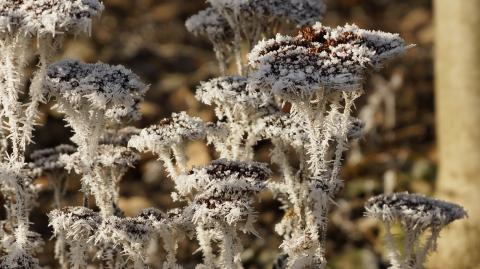Dormancy: A Key to Winter Survival

Do you ever wonder what’s going on in the garden when temperatures drop below freezing? How do perennials withstand the cold and dehydration of winter? Below the mulch, below the soil, a natural and extraordinary process of adaptation is happening.
To understand this process we can consider what’s going on at the cellular level. Cells of cold tolerant plants survive the winter by entering a deep state of dormancy, known as endo-dormancy. Depending on the plant, dormancy and cold acclimation can take days to weeks to be achieved. Triggered by changes in the angle of the sun, shorter day lengths, and cooler temperatures, plant hormones provide an initial signal that induces dormancy and cold tolerance. These signals result in a slowing of photosynthesis and respiration. In addition, plant enzymes that drive metabolism work poorly in the cooler temperatures. As a result, growth stops. Further, freezing temperatures halt the circulation of water within plant structures. When foliage dies and chlorophyll is lost, plants store carbohydrates and nutrients in their roots for winter sustenance and to initiate a growth spurt come spring.
During the winter, plants adapt to temperature changes by controlling when and where the water within them freezes. In a very real sense, plants create their own “antifreeze”. Individual plant cells accomplish this by accumulating sugars, salts, and other substances. These compounds are concentrated within the cells, decreasing their freezing point. Water moves from within each plant cell into the intercellular spaces thus protecting the cells from freezing. Ice crystals form in the interstitial spaces but not within the cells themselves.
Not only do plant cells manufacture antifreeze, they also change the permeability of their membranes and allow water to exit into intercellular spaces. As temperatures fall, water continues to move outside the cells, further concentrating the intracellular antifreeze. For many perennial plants, this process is most effective for air temperatures between 32 and 20°F. Prolonged exposure to harshly cold temperatures and desiccating winds will injure plant cells however. Fortunately for plant roots, soil temperatures do not fluctuate as much as air temperatures do. A thick layer of mulch and snow cover add further protection.
Dormancy is not only a survival mechanism, dormancy also provides a period of rest. Sugars and other carbohydrates produced by the plant in spring and summer, are used by the roots to survive the winter, and in the spring, these substances are used to initiate growth. Ultimately, dormancy is broken after exposure to longer periods of warmer temperatures, changes in the angle of the sun, and shorter nights.
Thinking about plant dormancy brings to mind the effect winter has on us humans. For many a gardener winter is, at best, something we have to put up with. At worst, winter is something we dread. Perhaps we can view our own winter dormancy not merely as something to get through until spring finds us back in our gardens. Perhaps we can view our winter dormancy as a period of restoration, a time for regrouping and rest in preparation for the seasons to come.
UNH Cooperative Extension Master Gardener volunteers share information about home, yard, and garden topics with the people of New Hampshire. Got questions? Master Gardeners provide practical help finding answers to your questions through the Ask UNH Extension Infoline. Call toll free at 1-877-398-4769, Monday to Friday, 9 a.m. to 2 p.m., or e-mail us at answers@unh.edu.
Do you love learning about stuff like this?
SUBSCRIBE TO Granite State Gardening newsletter
Got questions? The UNH Extension Yard and Garden Infoline offers practical help finding answers for your yard and garden questions.
Call toll free at 1-877-398-4769, Monday to Friday, 9 a.m. to 2 p.m., or fill out webform.

